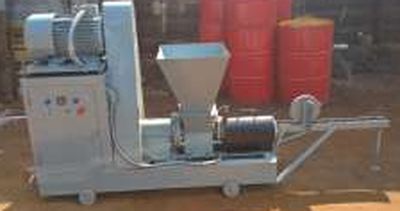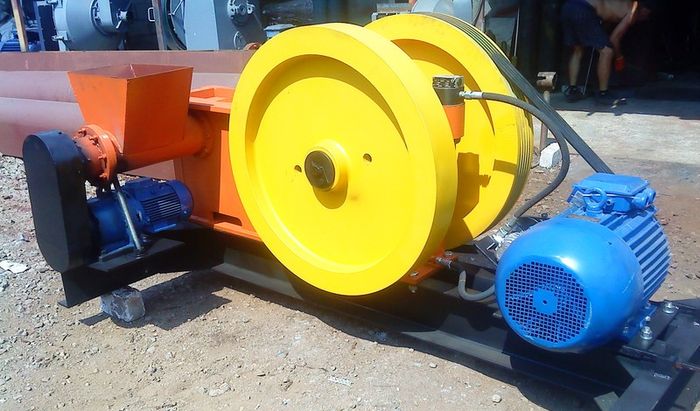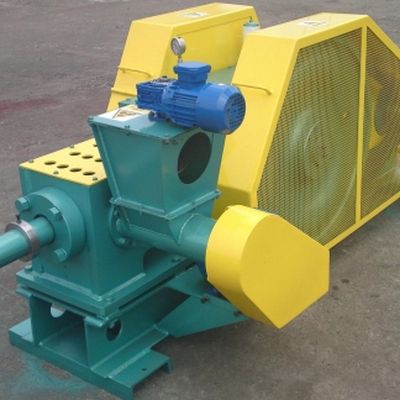Which briquette press to choose?
Sawdust, agricultural waste products, fallen leaves from trees and other types of plant debris can be first-class fuel. There are good benefits to be had from these affordable products. However, they are not used for ordinary boilers in their form - first you need to make neat pressed briquettes from them. If you do not process them, you will have to add this stuff every five minutes.
For the manufacture of briquettes, you need to use special equipment, for example, the PB-1 briquetting press is one of the most popular models.
Powerful presses for sawdust briquettes are now offered in a large assortment. And yet, the choice for many is essentially narrow due to the high price of equipment. But if you want to organize a permanent production, it is worth buying it - the costs, if used correctly, will definitely pay off. If you do not want to buy equipment, you can independently make a press for making fuel briquettes with your own hands. All this in the article.
What can be the equipment for briquettes?
Sawdust briquetting equipment comes in several varieties. It is classified according to the functions performed, the principle and features of work, characteristics and other parameters. It is divided into the following types:
- Hydraulic- such equipment is very cheap and will be affordable for most users. But the quality is not encouraging either - there are also good models, but often the briquettes made in this way have a low density and a short burning time, they can crumble during transportation.
- Auger- almost the complete opposite of the hydraulic type. Here the quality of the production products is at a high level: the shape is neat, similar to an irregular octahedron with a hole in the middle. The density of briquettes is very high, burning is long. Such products are expensive.
- Shock-mechanical- this kind of presses are widely used, as they combine acceptable quality and average prices. The density of the products of production is neither low nor high, they burn well and retain their characteristics for a long time.
- – is a typical compound feed granulator. Only instead of grain, they use other products - sawdust. The performance is at a decent level, the prices are also affordable, but there are some limitations. In this way, only small fraction products can be produced.
As you can see, each option is good in its own way and at the same time has disadvantages. To make it easier for you to determine which briquette press is better to buy in your case, we will consider the features of the equipment one by one.
Hydraulic briquette press: application, features, advantages and disadvantages
 A hydraulic sawdust press is well suited for those who are on a tight budget. There are even very cheap options here, but the functionality here will be more modest, and the quality of production products is not always high.
A hydraulic sawdust press is well suited for those who are on a tight budget. There are even very cheap options here, but the functionality here will be more modest, and the quality of production products is not always high.
This technique has gained great popularity in small industrial enterprises. Now it is beginning to be actively used in repair shops.
The principle of operation of the equipment is based on the pressure created by the liquid. It is an efficient waste material handling device. You can buy models with individual and group drives. If you decide to purchase a sawdust briquetting press of this kind, pay attention to modern models.
Key Benefits:
- work with a variety of materials;
- the noise level during operation is low;
- workpieces are fed with high precision;
- the design is strong and reliable;
- the device works fast enough;
- in some models, you can specify the desired speed.
In addition, modern devices allow software control. Most of the work is automated. Professional skills are not required. Time spent on work - a minimum, the result - to the maximum. But "fancy" models, of course, are more expensive than "standard".
You can save more on your purchase if you find a used briquetting press in good condition. But be careful! Let the master assure that the equipment is working before buying.
Screw press: what is it, is it worth using?
 Such equipment by the principle of operation resembles a meat grinder familiar to everyone. With its help, the sawdust is thoroughly crushed and dried, after which it is fed through the auger through the die. Thus, the mass is compressed to its maximum density. This method of pressing is very effective, because with it high pressure acts on the manufactured products.
Such equipment by the principle of operation resembles a meat grinder familiar to everyone. With its help, the sawdust is thoroughly crushed and dried, after which it is fed through the auger through the die. Thus, the mass is compressed to its maximum density. This method of pressing is very effective, because with it high pressure acts on the manufactured products.
Another characteristic feature of this technique is the use of a high temperature regime. If the desired temperature is not available, the system may simply stop working - the equipment will jam. Compliance with the operating conditions must be well monitored!
The screw press for briquettes combines practicality, versatility and precision. Everything about this design is well thought out. For example, due to the same hot air flow, lignin is released from wood. Thanks to it, the raw material is well bonded - due to this, high quality molding is ensured.
Lignin is a naturally occurring substance with a binding effect.
Advantages and disadvantages
The screw device has good performance properties:
- according to experts, is the most highly effective solution;
- briquettes of excellent shape are obtained;
- reliable and durable products are manufactured;
- transportation such products tolerate perfectly;
- work accuracy at a high level.
Among the main weaknesses are the high cost of equipment and the need for heating - because of this, the preparation procedure takes longer. The exact price of a sawdust briquette press depends on the model, characteristics and functionality.
Characteristics and features of the impact mechanical press
Briquetting press of this type is widely used in the domestic market and not only. Its principle of operation resembles the functioning of a perforator. Everything is based on the fact that the crank mechanisms with a certain frequency (directly set by the user) transmit shocks to the piston. And already thanks to the piston strokes, the sawdust, previously sent to the chamber, is forced through the spinneret. As you can see, everything is simple, clear and easy.

What are the advantages and disadvantages of the equipment?
You can buy such equipment without fear. It is not too expensive, and the quality of production products is at a decent level. The main positive qualities of a shock-mechanical press:
- You can make briquettes from a variety of materials, not just from sawdust. For example, the technique is often used to process grinding and coal dust, straw, and other products.
- It is possible to produce briquettes for different operating conditions. That is, you can both produce high-quality products for sale, and prepare reliable materials for industrial needs.
- The mechanism here is quite simple, besides, the equipment can work for a long time and in the absence of a responsible person - you can well automate the production process.
- The performance index of the unit is at a good level. It is more efficient than hydraulic equipment, but less productive than a screw press.
Among the shortcomings, again, the price may be. For “primitive” and even standard ones, it is acceptable, but fancy models are expensive. Another weakness is the rapid wear of the crank friction units - after all, they are affected by both impact force and friction at once.
Pellet press: principle of operation, positive and negative properties
 Now granulated materials are very popular, not only as a fuel, but also as a raw material for further processing. For their manufacture, equipment such as a granulator press is needed.
Now granulated materials are very popular, not only as a fuel, but also as a raw material for further processing. For their manufacture, equipment such as a granulator press is needed.
Such a technique on the market has become a real find. With its help, transportation is much easier, because granular products are much easier to transport! Yes, and it is more convenient to store and use it in business - everything is stored in a compact form.
The process of producing granules using this technique is simple:
- Prepared raw materials for production. It is carefully checked whether there are any impurities in it.
- The checked and cleared raw material goes to the loading bunker.
- Here it mixes well.
- From the bunker, the mixture is sent to the feed chamber.
- Then it is placed in the mixer.
- Here the products are processed.
- The mass is dispensed onto the matrix element and, under the pressure of the press, is forced through the holes - granules appear at the opposite end of the matrix.
- The punched particles are cut to the required sizes.
Such a press for the production of fuel briquettes has not the highest cost and works with good performance. Among its disadvantages can be called the grinding of raw materials to a minimum size. In addition, it is necessary to prepare the raw material in advance and add a binder to it so that the briquettes are obtained with a high density.
How to make a press with your own hands?
First of all, you need to decide what type of device you want to build. If you want a lever/screw version, you won't need to buy a lot of products. However, they do not differ in high density of briquettes.
You can make your own press from a hydraulic jack. If desired, it can be equipped with an electric or manual drive.
- Connect the punch to the hydraulic jack.
- Make a matrix from a pipe with thick walls, make small holes in it - so air and moisture can escape.
- Install the removable bottom to the matrix. When you remove it, it will be possible to push the manufactured briquette into the receiving tray.
- Install the operating mechanism directly into the housing. Equip it additionally with handles - so it will be easier to move it.
Acting according to the instructions, you can even make a manual briquette press yourself. But it's quite difficult to do so! With small mistakes, all the work can go down the drain. It’s good to have a specialist in the manufacture of presses in touch with you - so you will know if you are doing everything right.
By making your own equipment, you can save a lot of money. The cost of the simplest equipment can reach up to 200,000 rubles, and reliable and multifunctional devices can cost from 300,000 to 1,000,000 rubles. Mini-presses are more affordable - their prices are in the region of 70,000-100,000 thousand.
